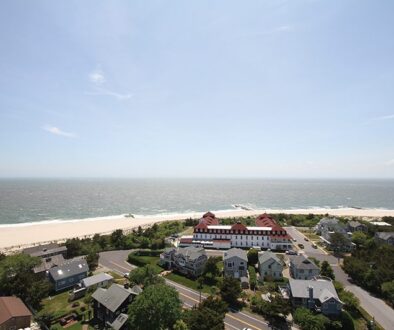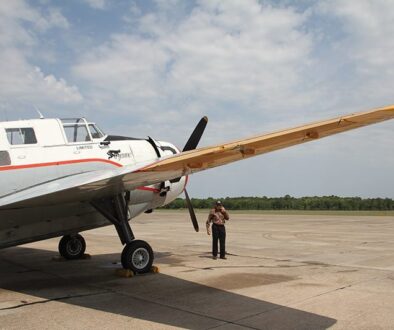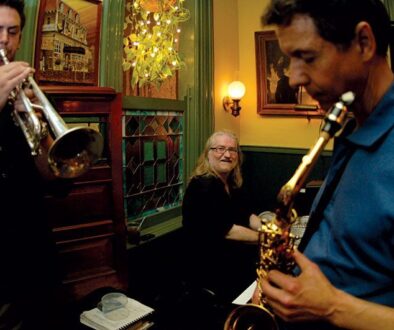Mary O’Hara: Jersey Girl
At the end of the 19th century, Cape May Point was a thriving little community established as a religious retreat by prominent ministers and businessmen. Here, on July 10, 1885, a baby girl was born to the Reverend and Mrs. Reese Alsop. They called their daughter Mary O’Hara, after her maternal grandmother. Years later, upon the publication of her best-selling novel, My Friend Flicka, about the young son of a Wyoming rancher and the special horse he loves, the world would call Mary one of the most talented writers of her generation.
The Alsops were passing through Cape May Point on their way to the Episcopalian clergyman’s new Brooklyn parish when Mary entered the world. Though the exact location of Mary’s birth is unknown, Mrs. Alsop’s journal notes that she was attended by both a doctor and a nurse—unusual for the times and indicative of the Alsops’ position in society. Mary’s birth at Cape May Point gave the Alsops their third of four children. It also gave Reverend Alsop the perfect nickname for his beloved daughter.
“On the July night I was born my parents were traveling through New Jersey to take up my father’s new position,” wrote Mary at age 90 in her autobiography, Flicka’s Friend. “I was, as it were, dropped en route. So I became ‘Jersey’ to my father.”
“Jersey’s” childhood was privileged. She, her parents, older sister Elma, older brother Reese and younger sister Bess lived in the select neighborhood of Brooklyn Heights. There were private schools, pretty dresses and parties. Summers were spent at Deercreek, the thousand-acre estate outside of Pittsburgh owned by her wealthy grandmother, Mary O’Hara Denny Spring. Grandma May, as she was known, was an elegant, cultured woman who had a profound impact on young Mary. Grandma May imparted her love of music and her talent as a pianist to her granddaughter, who regarded music as a thing of wonder.

“It flooded me with happiness. It was as if I opened a door into another world and that world was full of surprises and peace and beauty,” wrote Mary.
When Mary was six years old, her mother died, and Grandma May assumed an even bigger role in her life. Grandma May travelled to Europe several times with Mary and her sisters, staying at grand hotels and introducing the girls to fashionable, accomplished people. In addition to her relatives, Mary’s constant companions were her music—she became an accomplished piano and violin player—and her writing.
“I was destined to be a writer. I might almost say predestined, for I wrote my first short story when I was seven. As soon as it was finished I wrote another, and since then have never stopped writing.”
Upon their return from Europe, Grandma May moved the extended family into a big house in Brooklyn. Mary’s teenage years had all the hallmarks of a wealthy New York upbringing. She attended finishing school, made her debut to society and was courted by many young men. In 1905, against her father’s wishes, Mary married her third cousin, Kent Parrot, a charming and dashing young man with vague plans to enter law and politics. After the birth of their daughter O’Hara, they moved to Los Angeles and welcomed a son they called Kent. For several years, their lives were a swirl of country club dances, golf, parties and a parade of interesting people. (One day on the 18th fairway of the Los Angeles Country Club, Orville Wright taxied up to Mary in his new plane and offered to take her flying. Mary accepted.) Mary and Kent’s glittering life was eventually marred by Kent’s wandering eye, though, and they divorced.
Around this time, two exciting things happened that fed Mary’s artistic soul and also yielded an income for raising her children: she purchased her first piano, a cherished possession upon which she would successfully compose numerous songs for publication, and she became a screenwriter for Metro Pictures, one of the four big motion picture studios in Hollywood.
The 1920s were the zenith of the silent film era. Developing scripts for the silent screen involved the very specific craft of continuity writing. This was the intricate process of turning an original story or book into a script, complete with stage directions and the brief titles that would appear on screen to provide background to the audience. The best continuity writers received up to eight thousand dollars per script—a fortune in those days. Mary became one of the best, and was known as the Queen Bee for her talent. She went on to work with famous filmmakers such as Cecil B. DeMille, and to write continuities at Metro, Paramount and Warner Brothers studios for over 15 silent films, including The Last Card (1921), The Prisoner of Zenda (1922), Braveheart (1925), and Framed (1927).
Mary’s second marriage took place during this prolific period. The end of World War I brought Helge Sture-Vasa to America. This strapping blond Swede was the son of a diplomat and a veteran of the U.S. Army’s Remount Service, which provided horses for troops during the war. Helge became a set builder in Hollywood, where he met Mary in 1922. Their marriage was a happy one in the beginning, marred only by the tragic death of Mary’s daughter O’Hara from Hodgkin’s Disease.
After O’Hara’s death, Mary and Helge moved to Wyoming in 1930 and bought a ranch outside of Cheyenne. Mary was captivated by the expansive vistas and wild horses who roamed freely in this beautiful part of the country. Helge named the home Remount Ranch, in honor of the horses he cared for during the war. His intention was to make his fortune as a sheep farmer. Mary was skeptical, but happy to make the move.
“I was ready for Wyoming,” she wrote.“It was almost as if I had intuited the fact that in Wyoming I would meet and get acquainted with those wild horses which roam our western plains. And, unless that had happened, I never could have written My Friend Flicka.”

One of these wild horses in particular became Mary’s inspiration for her novel. Mary was devoted to a young filly that, like Flicka of the novel, became entangled in barbed wire near a stream while roaming the range. After realizing she couldn’t free her pony alone, Mary hurried home for help. By the time they returned the next morning, Mary’s filly had died of her injuries. Mary was bereft. When she started writing My Friend Flicka at age 56, she decided to create a happier ending by having the young protagonist, Ken McLaughlin, stay by his Flicka’s side throughout the night. Ken’s love pulls his pony through, though at great cost to his own health.
Remount Ranch had its own trouble pulling through. The Great Depression had ruined its prospects as a sheep farm. To make ends meet, Helge and Mary opened the ranch as a summer camp for wealthy prep school boys. However, with the 1941 publication of My Friend Flicka, Mary’s writing career took off and life on the ranch became easier. The sequel, Thunderhead, followed in 1943 and Green Grass of Wyoming, the final book of the trilogy, in 1946. Twentieth Century Fox made each book into a movie during the 1940s, and My Friend Flicka was also developed into a 39-episode television series that ran from 1955 to 1956.
Unlike the success she experienced with her writing, Mary’s marriage to the philandering Helge was failing. They divorced in 1947 after 25 years together. Mary was alone again, but that didn’t stop her from living life.
“Her writing and integrity was how she weathered the storms of her two marriages,” said Melanie O’Hara, former faculty member at the University of Wyoming at Laramie, where she helped archive many of Mary’s personal papers for the school’s American Heritage Center.

Mary moved to Connecticut and built a house where she continued her writing and composing. She eventually wrote nine books, including The Son of Adam Wyngate in 1952 and Wyoming Summer in 1963. Despite her prolific writing, Mary never neglected her music, composing a folk musical titled The Catch Colt in 1961, and creating many well-regarded piano compositions, including May God Keep You and Wind Harp.
Mary’s later years were rich with grandchildren, her siblings and their families, and friends. My Friend Flicka was translated and published into 14 languages, and remade as a movie in 2006. At age 71 Mary saw The Catch Colt performed at Catholic University in Washington, D.C. and again in Cheyenne. Her writing and composing continued, both from Connecticut and from her second home in Washington, D.C. near Kent and his family. Even the gradual loss of her vision couldn’t prevent her from writing, and she began her autobiography, Flicka’s Friend, on her ninetieth birthday. In it she said, “I am not just marking time. I could not do that. It would be too boring. Besides, no prolific writer comes to the end of one piece without another —sometimes two or three—already taking shape in his mind.”
Mary O’Hara died on October 14, 1980 at age 95. Cape May Point’s hometown girl had led a full and exciting life, leaving behind a rich writing and composition legacy.



